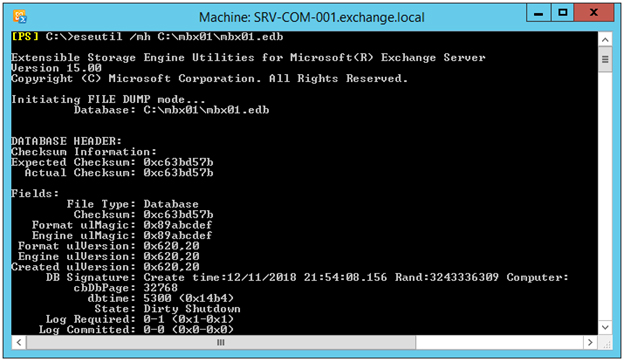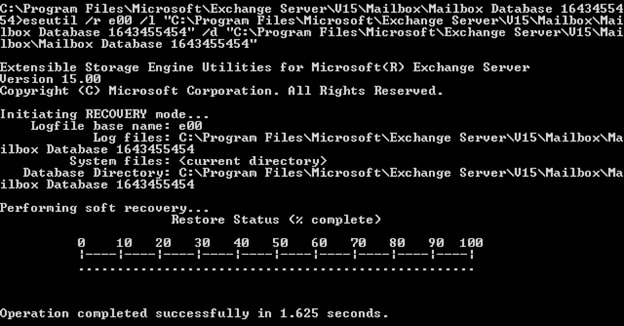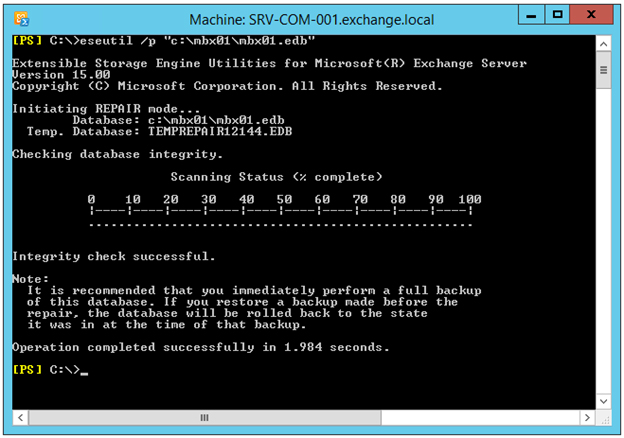MS Exchange Server has two fundamental components, i.e., the Information Store and the JET Database Engine. The Information Store consists of two databases, namely 'Priv.edb' and 'Pub.edb'. The private information store database (Priv.edb) is responsible for managing user mailboxes, whereas the public information store (Pub.edb) is used for Public Folders. The JET database engine performs disk caching and is also responsible for maintaining the disk structure for Exchange Server.
Most of the time the Information Store gets corrupt, rendering all data in the EDB file inaccessible. This corruption may occur as a result of malicious attacks, bad sectors on the hard drive, server crash, abrupt shutdown, missing or deleted transaction logs, etc.
This can cause the transaction logs to be incorrectly read by the server, which may lead to incorrect updates and inconsistencies in the Exchange database (EDB).
You may also encounter EDB file corruption due to abnormal termination of the Information Store. When transaction logs are not committed to the database before the server crash or shutdown, it causes Dirty Shutdown and dismounts the database.
When you try to mount 'Priv.edb' after a dirty shutdown, you may come across the following error message:
"Database was not shutdown cleanly (dirty shutdown)"
You may also check the database status by using Eseutil /mh

The Dirty Shutdown error indicates that the database is inconsistent and probably corrupt as the database file was not properly updated. Thus, the next time when you start the database, Exchange Server searches the log files for missing data. If the log files are missing, the database cannot be mounted. In such a case, you need to repair the Exchange database.
In Microsoft Exchange, you can use the Eseutil and IsInteg utilities to efficiently repair the inconsistent Exchange database. You can use Eseutil cmdlets to perform soft recovery. However, this works when the database is inconsistent due to uncommitted transaction logs.
If the database is corrupt or damaged, you are required to perform hard recovery by using the Eseutil cmdlet, followed by IsInteg.
However, hard recovery removes damaged or unrecoverable data during recovery, which can lead to significant data loss. Thus, it’s not recommended. Instead, you can use an Exchange EDB repair software, such as Stellar Repair for Exchange, to recover mailboxes from a corrupt database and then restore the recovered mailboxes to a new or different database.
Below we’ve discussed both methods to repair corrupt EDB files.
Eseutil is a command-line utility that can be used to defragment an Exchange database offline, verify the database integrity, and repair a damaged database. The utility can be found in the C:\Program Files\Microsoft\Exchange Server\V15\Bin directory.
It can effectively fix all integrity issues related to the Information Store and the directory. Once located, execute the following command to perform soft recovery:
ESEUTIL /r EX01 /L D:\mdbdata /s C:\exchsrvr\mdbdata /d F:\mdbdata /i
- Here, EX01 is Log File Prefix that resides in D:\mdbdata
- C:\exchsrvr\mdbdata represents CHK (Checkpoint), EDB (Database), and STM (Streaming) file location
- /i switch (optional) is used to avoid streaming error and ignore the missing database

If this fails to repair and recover the database, you may choose to perform hard recovery by using the following Eseutil command:
ESEUTIL /P

After performing the hard recovery, you need to check the database integrity by using the 'ISINTEG' utility.
The 'Isinteg' utility identifies the Exchange database as an ESE database and verifies the database tables, their records, and indexes. The utility records all information about the recovery process to the application log in the Event Viewer.
After this, you may try to mount the database.
Stellar Repair for Exchange is a competent tool that performs EDB repair and restores users' mailboxes. It uses safe and highly reliable algorithms to scan the corrupt EDB files. The Exchange EDB repair software can efficiently extract and restore your precious emails, contacts, tasks, attachments, calendar items, and other mailbox items without causing any further damage to the original EDB file.

This Exchange EDB repair tool also works with Unicode-formatted EDB files and allows selective recovery of user mailboxes. Furthermore, the software supports MS Exchange Server 2019, 2016, 2013, 2010, 2007, 2003, 2000, and 5.5.
You can follow this guide to repair the EDB file with the help of Stellar Repair for Exchange.
Exchange database or EDB file corruption is a common issue in Microsoft Exchange. It not only disconnects the user mailboxes but also disrupts the email services. Although Exchange administrators can use the inbuilt Eseutil and IsInteg utilities to repair inconsistent or corrupt databases, they may not work or lead to data loss during database recovery.
However, such situations can be avoided by using reliable Exchange EDB repair software, such as Stellar Repair for Exchange. The software recovers mailboxes from an inconsistent or corrupt database and restores the mailboxes into a new database on the same or different live Exchange server (same forest) directly.
- Fixing Exchange Error 550
- How to Recover Information Storage Group
- How to Recover Corrupt Priv1.edb File
- How To Restore Lost Active Direcovery Data
- Solution for Various Exchange Server Errors
- How to Fix Event ID 447
- Fixing Error C1041739 in MS Exchange Server
- Simple Ways to Fix Page Checksum Mismatch Error
- Resolving Exchange Dirty Shutdown Error
- Simple Methods to Solve Exchange Error 327
- Solution for Failed to Mount Database in Exchange Server
- How to Resolve Page Read Failed Verification Error
- Brick-Level backup - Not Recommended for Restore Exchange Mailboxes




